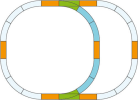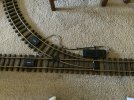inane question number 3 (or it maybe more I’ve lost track, not train track)
So I’m thinking of laying a double oval track so that I can keep two engines on the track . I want to ’park’ a second engine in one of the ovals and be able to change to the other so how do I insulate it so they don't both move at the same time?
So I’m thinking of laying a double oval track so that I can keep two engines on the track . I want to ’park’ a second engine in one of the ovals and be able to change to the other so how do I insulate it so they don't both move at the same time?



